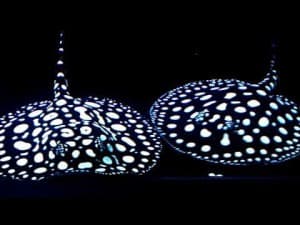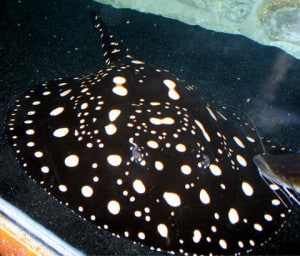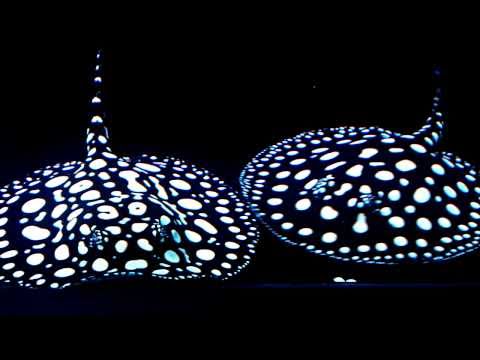
Common name: Leopoldi Stingray, Polka Dot Stingray, Black Diamond, P13, P14, P62
Scientific name: Potamotrygon leopoldi
Average Adult Fish Size: 24 inches / 60 cm
Place of Origin: Rio Xingu basin and Rio Fresco in central Brazil.
Typical Tank setup: Filtration is one of the most important aspects of a ray set-up. A large and efficient biological filter is needed to cope with the amounts of biological waste produced by an active, predatory fish of this size. Dim lighting is preferable, although once settled in most rays will also be active under brighter conditions. Plants that require rooting in the substrate will be eaten. Use river sand as this will give a lovely natural look.
Recommended Minimum Aquarium Capacity: 265 gallon / 1000 litre
Compatibility: Rays have to be among the top predators in the habitats they live in nature and are unsafe to keep with most other species. On the contrary they also seem to prefer a quiet life and will often fail to thrive when kept alongside very aggressive or territorial companions. The best tank mates are large enough not to be eaten, peaceful and ideally occupy the upper parts of the tank. Some cichlids, such as Oscars work well. Plenty of enthusiast’s arowanas with their rays, and in a spacious tank this can be a very remarkable combination.
Temperature: 68 – 88 Deg. F / 20 – 29 Deg. C
Water chemistry: pH 6.0 – 7.5
Feeding: Wild rays feed primarily on other fish and invertebrates, including worms and crustaceans. They’re active fish with a high metabolic rate and as such will need feeding at least twice a day. They’re also notoriously big eaters and it’s going to cost you a lot of money to keep even a single ray in good health. In general an exclusively meaty diet is preferable, although some will also learn to accept dried foods.
Sexing: Rays are easy to sex. Males have a pair sexual appendage known as “claspers”, one on each pelvic fin. These are used to inseminate the female when mating and are clearly visible, appearing as finger-like extensions extending backwards from the inside of the fin. In young males they’re much smaller, but can still be seen if you look closely.
Breeding: Rays can be picky when it comes to choosing a mate. Simply buying a pair of rays and putting them together will not guarantee a successful pairing. The ideal way to obtain a pair is to buy a group of juveniles, housing them in a huge tank and allowing them to select their own partners.
The spawning act itself is quite brief, lasting only a few seconds. Fertilisation occurs internally, the male inserting one of his claspers into the cloaca of the female before releasing his milt. Following a successful mating event the male should stop harassing his partner.
In captive rays generally takes between 9-12 weeks. During the latter stages the developing young can sometimes be seen as a visible lump rising from the posterior end of the female’s back, although in well-fed specimens this can be tricky to spot. It’s essential to feed the female in sufficient quantities during this period as she will expend a lot of energy providing for her pups, and her appetite will increase significantly.
The pups usually have a small yolk sac attached at birth, and they will feed from this for anything up to a week. After the sac has been absorbed they should be offered high quality live and frozen foods several times a day.
Additional Information: Leopoldi Stingray is arguably one of the most stunning freshwater species in the hobby and comes with a price tag to match.
Along with sawfish and sharks all rays they have no bones in their body, with the skeletal structures being composed primarily of cartilage.
These fish are dangerous. Most natives of the countries in which they’re found are far more fearful of rays than other supposedly life-threatening species, such as piranha.
The actual stinging apparatus or spine is formed from dentin and possesses associated venom glands.



Related Posts
Croaking Gourami – Trichopsis vittatus
Benthochromis Tricoti
Large-eyed Mouthbrooder – Callochromis Macrops